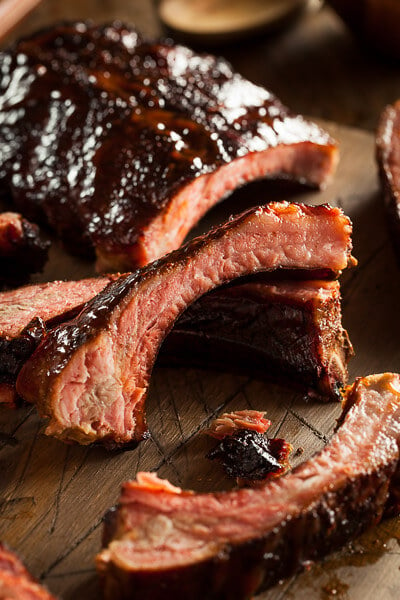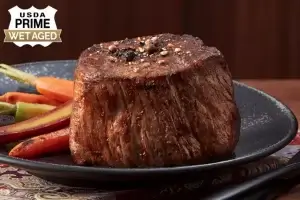
It’s tough to compare anything to a delicious rack of pork ribs ordered from your favorite steakhouse — except, maybe, being able to replicate the meal in your own kitchen. This guide covers all the ways to cook pork ribs using your own equipment, like how to cook pork ribs on the grill or how to use your instant cooker to do the job.
How to Pick the Best Pork Ribs
First, let’s cover what you need to know to pick the best pork ribs at the store, as there are several factors that should go into your decision.
Start by evaluating the appearance of the pork ribs. The ribs should have a healthy pink color with some marbling running through the meat. If you see thin white strips running through the ribs, that’s the marbling. Marbling helps tenderize and flavor the pork when cooking, so it’s an important part of assessing the overall quality of pork ribs.
Next, look at the thickness of the ribs. You want ribs that are about 1 ½ inches thick. More importantly, the ribs on the rack should be relatively similar in thickness to ensure thorough, even cooking.
Now, use the finger test. Gently push your fingertips into the meat of the ribs. Healthy and fresh ribs should feel firm but have a slight bounce-back.
Finally, note the sell-by date of the ribs. The ribs should still be within their sell-by date. If you’re not using them right away, be sure to choose ribs that will still be within the sell-by date when you’re ready to use them. For best results, plan to use your ribs within 1-2 days of buying them unless you’re freezing them.
Prepare the Ribs
Just like you would with steak, prepare your pork ribs before cooking them to ensure excellent results.
Pork ribs typically come with some extra fat on them, so you’ll want to first trim this off. Look for gobs of fat, which often sit near the ends of the rib meat. They won’t have enough time to break down unless you’re using a slow-cooking method like smoking, so it’s easiest to take them off now rather than trying to remove fat after it cooks.
There’s also a thin membrane on the back of the rack of ribs. It’s like a thin, translucent film. It helps to remove this before cooking to make sure all sides of the ribs get flavored from your seasonings or sauce and to ensure more even cooking. You can lift up on the end of the membrane and carefully and slowly slide a sharp knife underneath to remove it.
Once you’ve completed these steps, it’s time to decide whether you want to season or marinate your ribs.
To Season or Marinate?
Pork ribs can be seasoned or marinated. Even if you choose to add sauce to your ribs, you should still decide whether you want to season or marinate them for the best flavor.
Seasoning is great when you want to grill or smoke ribs, especially if you use more of a dry rub style of seasoning. A blend of herbs and spices adds flavor to the ribs while creating a crispy crust. You can spread barbecue sauce or other sauces over the top of your spices, if desired, while cooking.
Marinating is also a solid choice. A rib marinade soaks into the meat, adding flavor while tenderizing it. If you’re going to oven-cook or air-fry your ribs, a marinade can help prevent the ribs from drying out.
If using a marinade, try to have the ribs marinate for at least 30-60 minutes. If you have enough time to let them marinate for 6-8 hours, even better. Keep them in the refrigerator while marinating, and pat them dry completely before cooking. Reserve some marinade to baste the ribs with while cooking.
Flavor Variations for Pork Ribs
The best thing about pork ribs is that you can make them taste different every time you make them, depending on the spices, sauces, or marinades you use. Here are a few of our favorite pork rib flavor profiles to inspire your creativity:
- Traditional barbecue pork ribs: Create a homemade barbecue sauce or use your favorite bottled sauce for a traditional, country-style pork rib. Season with garlic powder, cayenne pepper, salt, pepper, and paprika before adding the barbecue sauce.
- Hawaiian-style pork ribs: This flavor profile gives pork ribs a fun, sweet-and-sour taste. Marinate the ribs in a mixture of vinegar, pineapple juice, soy sauce, brown sugar, and garlic. Reserve some of the marinade to spread on the ribs while cooking.
- Teriyaki-glazed pork ribs: Bring the flavors of a Korean barbecue to your table with this flavor variation. Blend teriyaki sauce with brown sugar, garlic, and chicken or vegetable broth in a pot. Allow the mixture to come to a boil before turning the heat to low and simmering for 5-10 minutes until it thickens. Spread the mixture on the pork ribs before and during cooking.
- Balsamic pork ribs: Balsamic vinegar is perfect for Tuscan-style pork ribs. Season the ribs with Tuscan spices like fennel, thyme, and rosemary. Before cooking, brush balsamic vinegar onto the ribs, brushing another layer on about halfway through the cooking process.
Methods of Cooking Pork Ribs
Before cooking pork ribs using any of these methods, follow the steps we listed above to prepare them properly.
How to Cook Pork Ribs in the Oven
Oven-baked pork ribs are cooked low and slow, allowing the meat to become fall-off-the-bone tender. If you have a little extra time to spare, consider using this method.
Start by preheating the oven to 275℉. Prepare the pork ribs with your choice of seasonings, sprinkling the seasonings generously along all ribs. Then, transfer the ribs to a foil-lined baking sheet with the bone side facing down. Cover the ribs in foil before transferring the pan to the middle oven rack.
Bake for 2-4 hours; the exact time will depend on your oven and the thickness of your ribs. Look for the meat to pull away from the bone easily with a fork as an indication that they’re done. Remove the foil and brush the ribs with barbecue sauce. Place them under the broiler, uncovered, for 1-2 minutes to crisp. Rest for 5-10 minutes before serving.
How to Cook Pork Ribs on the Stove
Boiling is a simple cooking method to use when you want tender, juicy pork rib meat, especially if you don’t care about having the bone attached while you eat. This is a good option when you want to top potatoes or rice with pork rib meat, for example.
Cut the ribs so that they fit in a large pot. Add water or beef stock to the pot so that it covers the ribs. Add a couple of bay leaves to the pot and a sprinkle of parsley and oregano. Bring the water to a rolling boil before lowering the heat to a simmer. Cover the pot and allow to simmer for 30-45 minutes. Remove the ribs from the pot and pat them dry. Then, sear the ribs in a hot skillet with a drizzle of oil to brown them.
Rest for 5-10 minutes. Leave the ribs on the bone or use a fork to gently scrape the meat from the bone.
How to Grill Pork Ribs
Prepare the pork ribs with your choice of seasoning. A dry rub works well for grilled pork ribs.
Then, fire up the grill to around 275-300℉. Wrap the ribs in aluminum foil before placing them on the grill. Cook for 1-2 hours or until the rib meat can be pulled off easily with a fork. Place the ribs on a plate and carefully remove the foil. Baste with your desired sauce before moving them back to the grill, cooking for another 5-10 minutes until browned.
Remove the ribs from the heat and rest at room temperature for 5-10 minutes before serving.
How to Cook Pork Ribs in Instant Pot
Season the ribs as desired and place them on the rack of your instant cooker. Pour ¾ cup of water and ¼ cup of apple cider vinegar into the pot. Cook on high for 25 minutes or use the automated pork setting on your Instant Pot, if it has one. Allow the pressure to release naturally for five minutes and then release it manually.
Next, broil your pork ribs for 1-2 minutes, allowing them to brown. Rest for 5-10 minutes at room temperature before enjoying.
How to Cook Pork Ribs in Air Fryer
Spray the air fryer tray with cooking spray and preheat your air fryer to 350 degrees for about five minutes while you season your pork ribs. Place the ribs on the rack. You may need to cut the rib rack in half and work in batches. Air fry for 20 minutes; then, rotate the ribs a half-turn and cook for another 15-20 minutes. Brush your favorite barbecue sauce or glaze onto the ribs before cooking them for another 3-5 minutes.
Rest for 5-10 minutes before serving.
How to Sous Vide Pork Ribs
You’ll need plenty of time for sous vide pork ribs to cook, so we suggest reserving this method when you’re looking to prepare ribs ahead of time for a next-day meal.
Add your seasonings or spice rub to the pork ribs. Add sections of pork ribs to sous vide bags with your chosen marinade, using a vacuum sealer to seal each bag. Allow to marinate in the refrigerator for 1-2 hours before cooking.
About 30 minutes before cooking, let the rib bags rest at room temperature. Set your precision cooker to 145℉. Add the packs of ribs and cook for 12-24 hours. Then, transfer to an ice bath to fully chill the ribs, usually for 15-30 minutes.
When you’re ready to brown them, preheat the oven to 300℉. Remove the ribs from their bags and transfer them to a foil-lined tray. Bake for 30-45 minutes until the internal temperature reaches 145-160℉. Rest for 5-10 minutes at room temperature.
How to Smoke Pork Ribs
Preheat a smoker to 225 degrees while you add dry rub to the ribs. Transfer the ribs to the smoker, allowing them to cook for about 2 hours. Spray the ribs with a mixture of water and apple cider vinegar. Then, cook for another hour before spraying the ribs again. Continue doing this hour-by-hour until the ribs reach 160℉. Now, wrap the ribs in butcher paper for the last hour or two of cooking. At this point, the ribs should be about 200℉.
If saucing the ribs, do so now, and smoke for another 30 minutes. Then, let the ribs rest for 5-10 minutes before serving.
Conclusion: How to Cook Pork Ribs
With multiple ways to cook pork ribs, you can’t go wrong. Stick to your favorite method or experiment with other ways you haven’t tried using our simple guides for each cooking technique.
Or, if you want delicious ribs ready to heat and serve, try our baby back ribs by Coach Ditka. They come pre-cooked, so all you need to do is reheat them to have expertly cooked ribs ready for dinner.


